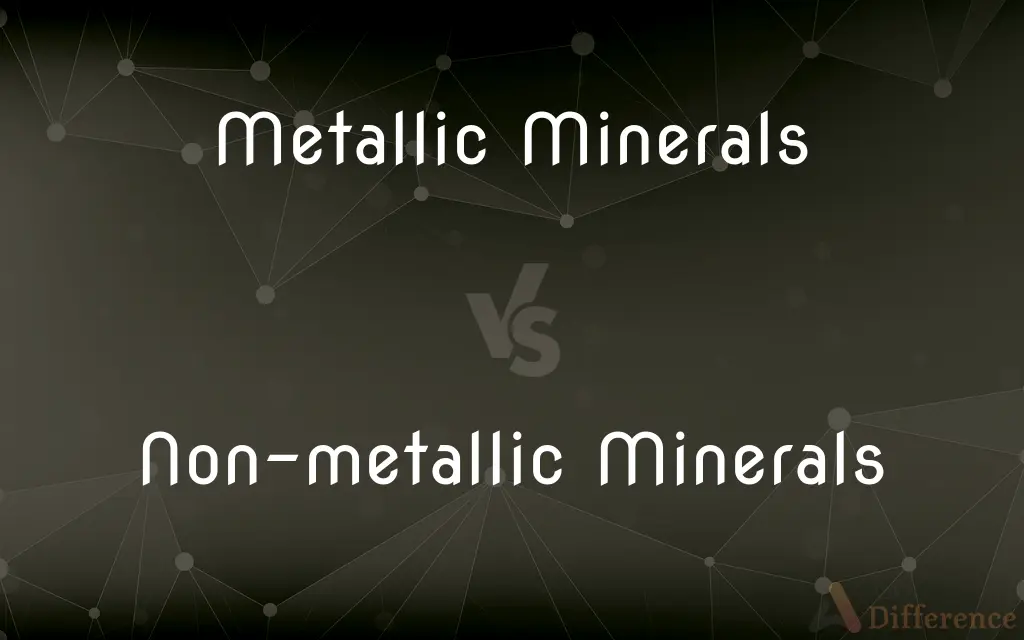Metallic Minerals vs. Non-metallic Minerals — What's the Difference?
Edited by Tayyaba Rehman — By Fiza Rafique — Published on December 12, 2023
Metallic minerals contain metal elements, are usually shiny and conduct electricity, while non-metallic minerals lack metal content, are diverse in appearance, and are insulators.

Difference Between Metallic Minerals and Non-metallic Minerals
Table of Contents
ADVERTISEMENT
Key Differences
Metallic minerals are characterized by their metallic luster and conductivity. They are often extracted for their metal content, which is used in various industrial applications. Non-metallic minerals, on the other hand, lack a metallic sheen and are poor conductors of electricity. They find use in a wide range of industries beyond metal production.
Metallic minerals are generally denser and have a higher specific gravity compared to non-metallic minerals. This makes them highly valuable for their metal content, leading to extensive mining activities. Non-metallic minerals, while less dense, are prized for their diverse properties such as hardness, color, or chemical composition, and are used in industries like construction and manufacturing.
In terms of economic value, metallic minerals often command higher prices due to their crucial role in producing metals. The extraction and processing of metallic minerals are significant contributors to the global economy. Non-metallic minerals, though economically valuable, typically have a more varied range of applications and are not always directly linked to metal production.
Geologically, metallic minerals are usually found in specific types of rock formations, often associated with volcanic and metamorphic processes. Non-metallic minerals, in contrast, can be found in a broader range of geological settings including sedimentary rocks, indicating a diverse origin.
Metallic minerals are typically extracted through mining and require extensive refining to extract the metal. This process can be energy-intensive and environmentally impactful. Non-metallic minerals are also mined, but the extraction and processing methods can vary widely, reflecting the diverse nature of these minerals.
ADVERTISEMENT
Comparison Chart
Composition
Contain metals
Lack metal content
Luster
Typically shiny and metallic
Diverse, often dull or glassy
Conductivity
Good conductors of electricity
Poor conductors, often insulators
Density
Generally denser
Less dense
Economic Use
Primarily in metal production
Diverse, from construction to tech
Compare with Definitions
Metallic Minerals
Substances with metallic luster and good conductivity.
Gold nuggets are found in quartz, a non-metallic mineral.
Non-metallic Minerals
Substances often insulating and not yielding metals.
Talc, a non-metallic mineral, is used in baby powder.
Metallic Minerals
Minerals with metallic properties and metal content.
Iron ore is a metallic mineral used in steel production.
Non-metallic Minerals
Minerals without metallic content and luster.
Gypsum, a non-metallic mineral, is used in drywall manufacturing.
Metallic Minerals
Naturally occurring substances yielding metals upon processing.
Copper is extracted from the metallic mineral chalcopyrite.
Non-metallic Minerals
Minerals with poor conductivity and varied appearances.
Calcite, a non-metallic mineral, is found in limestone.
Metallic Minerals
Ores from which metals can be economically extracted.
Bauxite, a metallic mineral, is the main source of aluminum.
Non-metallic Minerals
Naturally occurring substances with diverse properties excluding metal.
Quartz, a non-metallic mineral, is used in making glass.
Metallic Minerals
Minerals with a shiny surface and high density.
Galena, a metallic mineral, is the primary ore of lead.
Non-metallic Minerals
Resources widely used in industries other than metal production.
Potash, a non-metallic mineral, is vital for fertilizer production.
Common Curiosities
What are non-metallic minerals?
Non-metallic minerals lack metal content and have diverse properties, often used in various industries.
What are some uses of non-metallic minerals?
Non-metallic minerals are used in construction, manufacturing, technology, and more.
Are all non-metallic minerals dull?
No, non-metallic minerals can range from dull to glassy or even colorful.
Are metallic minerals good conductors?
Yes, metallic minerals generally conduct electricity well.
hat are metallic minerals?
Metallic minerals contain metal elements and have metallic properties like conductivity and shine.
Are metallic minerals always more valuable than non-metallic ones?
Not necessarily. The value depends on demand and application.
Do non-metallic minerals conduct electricity?
Non-metallic minerals are usually poor conductors of electricity.
Is density a distinguishing factor between these minerals?
Yes, metallic minerals are typically denser than non-metallic minerals.
Can metallic minerals be dull in appearance?
While rare, some metallic minerals can have a dull surface.
How are metallic minerals used?
Metallic minerals are primarily used for extracting metals for industrial applications.
Where are non-metallic minerals commonly found?
They are found in a broader range of geological settings, including sedimentary rocks.
Do metallic minerals have a specific geological origin?
Yes, they're often found in volcanic and metamorphic rock formations.
How are metallic and non-metallic minerals extracted?
Both are usually mined, but the processing methods can vary significantly.
Can non-metallic minerals be used in technology?
Yes, certain non-metallic minerals are crucial in technological applications.
Can a mineral be both metallic and non-metallic?
No, a mineral is categorized as either metallic or non-metallic based on its properties.
Share Your Discovery

Previous Comparison
Hospital vs. Nursing Home
Next Comparison
Living Things vs. Non-Living ThingsAuthor Spotlight
Written by
Fiza RafiqueFiza Rafique is a skilled content writer at AskDifference.com, where she meticulously refines and enhances written pieces. Drawing from her vast editorial expertise, Fiza ensures clarity, accuracy, and precision in every article. Passionate about language, she continually seeks to elevate the quality of content for readers worldwide.
Edited by
Tayyaba RehmanTayyaba Rehman is a distinguished writer, currently serving as a primary contributor to askdifference.com. As a researcher in semantics and etymology, Tayyaba's passion for the complexity of languages and their distinctions has found a perfect home on the platform. Tayyaba delves into the intricacies of language, distinguishing between commonly confused words and phrases, thereby providing clarity for readers worldwide.
















































